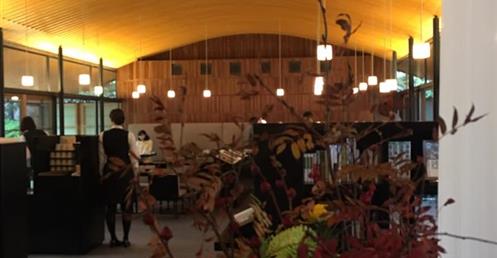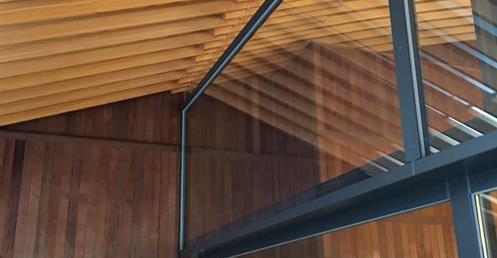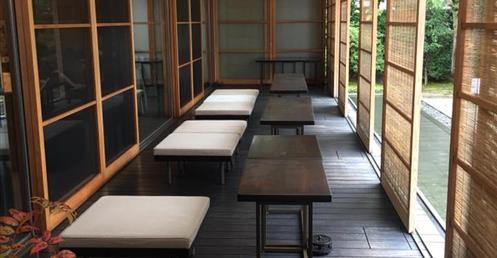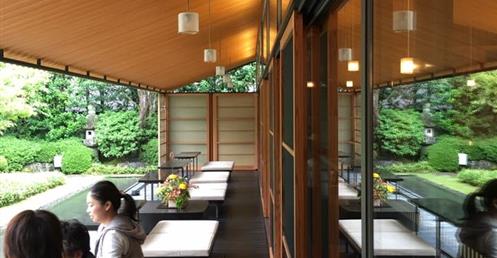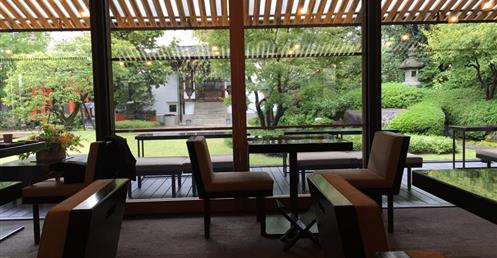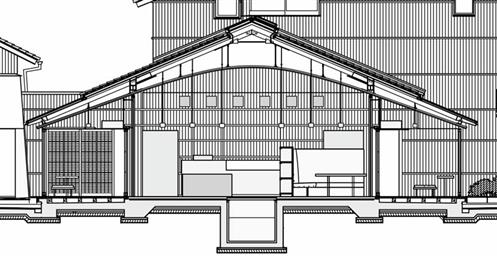Toraya Karyo Ichijo 2017
Kyoto, Japan
Designed by Hiroshi Naito
Photo & travelogue by Ding,Rong-Sheng
Quoted from https://www.facebook.com/777Tway?fref=pb&hc_location=friends_tab&pnref=friends.all
https://global.toraya-group.co.jp/pages/toraya
About Toraya
Toraya, a maker of wagashi (traditional Japanese confections), was founded in the early 16th century in Kyoto where it became a purveyor to the imperial court during the reign of Emperor Goyozei, which was from 1586 to 1611. Toraya established a foothold in Tokyo in 1869, after the national capital was transferred there on the heels of the Meiji Restoration. At present, Toraya has three factories and approximately 80 shops throughout Japan, in addition to a boutique in Paris.
Towards Next Century
Surviving the Great Kanto Earthquake and turmoil of World War II, Toraya Co. Ltd. was founded in 1948. In 1962, the company established a shop at Tobu Department Store in Ikebukuro. More outlets in department stores and train stations quickly followed with the total number of Toraya outlets skyrocketing.
The company looked overseas as well. It opened a shop in Paris in 1980 and another one in New York in 1993 (closed on October 31st, 2003) with the aim of introducing the culture of Japanese confections overseas.
Toraya Archives (Toraya Bunko) were established in 1973. Ancient records, documents, literature and other articles and wide assortment of materials related to wagashi, Japanese traditional confections, are catalogued and preserved.
The current proprietor of Toraya is the 17th generation. The company now has approximately 80 shops throughout Japan, mainly in Tokyo and Kyoto. While retaining the core values the company has held for centuries, challenges to enrich the traditions and to pass on to future generations a legacy that is even brighter than the one handed is going now.
虎屋菓寮 京都一条店
日本京都
設計 內藤廣
Kyoto, Japan
Designed by Hiroshi Naito
Photo & travelogue by Ding,Rong-Sheng
Quoted from https://www.facebook.com/777Tway?fref=pb&hc_location=friends_tab&pnref=friends.all
https://global.toraya-group.co.jp/pages/toraya
About Toraya
Toraya, a maker of wagashi (traditional Japanese confections), was founded in the early 16th century in Kyoto where it became a purveyor to the imperial court during the reign of Emperor Goyozei, which was from 1586 to 1611. Toraya established a foothold in Tokyo in 1869, after the national capital was transferred there on the heels of the Meiji Restoration. At present, Toraya has three factories and approximately 80 shops throughout Japan, in addition to a boutique in Paris.
Towards Next Century
Surviving the Great Kanto Earthquake and turmoil of World War II, Toraya Co. Ltd. was founded in 1948. In 1962, the company established a shop at Tobu Department Store in Ikebukuro. More outlets in department stores and train stations quickly followed with the total number of Toraya outlets skyrocketing.
The company looked overseas as well. It opened a shop in Paris in 1980 and another one in New York in 1993 (closed on October 31st, 2003) with the aim of introducing the culture of Japanese confections overseas.
Toraya Archives (Toraya Bunko) were established in 1973. Ancient records, documents, literature and other articles and wide assortment of materials related to wagashi, Japanese traditional confections, are catalogued and preserved.
The current proprietor of Toraya is the 17th generation. The company now has approximately 80 shops throughout Japan, mainly in Tokyo and Kyoto. While retaining the core values the company has held for centuries, challenges to enrich the traditions and to pass on to future generations a legacy that is even brighter than the one handed is going now.
虎屋菓寮 京都一条店
日本京都
設計 內藤廣
旅記 丁榮生
......
日本家居的完美,這就夠了一內藤廣的京都虎屋菓寮
家,就溫暖兩字,足矣!
每回進到京都虎屋菓寮,深深有股衝動,想問老闆,這房子賣嗎?我真想住這裏。
會有這個荒天大夢,主要在於內藤廣創造了這個溫潤的設計人。
他在京都虎屋果寮的案例,表達了軽鋼材搭木構所演出空間亁淨丶細節緊湊丶內外穿透,外加庭園宜沁,幾乎是「家屋」設計的典範。
而他的作品其實反映了這個人,事實上也有作品在台灣-台東史前博物館遺址現地陳列室,卻少有人知的紳士。具建築師身份之外,還曾是東京大學副校長丶建築學會會長,以設計極優秀木構建築丶提㩦後進丶精良行政能力而知名於日本建築圈。
他常用系統木鋼混合構成,並突顯集成材在生活面空間表現的細膩度。以我肖想的二條城京都御所邊的菓寮來説,這是伴手禮名店,也是1586年以來就是日本王室御用的和菓子店,而內藤廣則設計了其所有店舖,包括東京中城。
而京都店是評價最高的作品,這間仍保有室町時代傳統建築風格的現代主義作品,某種程度當然是業主的貢獻。例如門前小樹傍著水盤曲風折枝、石燈籠共擁一方池水,將京之家的「仿長安坊弄」氛圍表露無遺。
曲折而入門後,即見柵型大弧面天花板的挑高空間,格柵是由稀有的吉野杉切割成菱形斷面交拱排列而成,菱角形斷面旨在將藏於桷木之後的橘光燈的漫光灑落均勻,使得簡約的空間受光面有最大面積。王銘顯建築師今天告訴大家,這面格柵式天花板仍具結構作用,與二坡鋼架形成三角對位的張弦衍架關係,所以木柵天花並非裝飾,因此作法,才使空間軽巧的細鋼柱得以存在,並增添內外通透的最優化形態。
此外,後庭園也是焦點,由外伸屋簷形成的半戶外廊,更有空間壓縮作用,並形成框景效應,戶外賞景、聽雨之餘,映入眼簾的後院稻荷神社,有著橘色小鳥居,書寫著京之庭的人文意涵。
......
日本家居的完美,這就夠了一內藤廣的京都虎屋菓寮
家,就溫暖兩字,足矣!
每回進到京都虎屋菓寮,深深有股衝動,想問老闆,這房子賣嗎?我真想住這裏。
會有這個荒天大夢,主要在於內藤廣創造了這個溫潤的設計人。
他在京都虎屋果寮的案例,表達了軽鋼材搭木構所演出空間亁淨丶細節緊湊丶內外穿透,外加庭園宜沁,幾乎是「家屋」設計的典範。
而他的作品其實反映了這個人,事實上也有作品在台灣-台東史前博物館遺址現地陳列室,卻少有人知的紳士。具建築師身份之外,還曾是東京大學副校長丶建築學會會長,以設計極優秀木構建築丶提㩦後進丶精良行政能力而知名於日本建築圈。
他常用系統木鋼混合構成,並突顯集成材在生活面空間表現的細膩度。以我肖想的二條城京都御所邊的菓寮來説,這是伴手禮名店,也是1586年以來就是日本王室御用的和菓子店,而內藤廣則設計了其所有店舖,包括東京中城。
而京都店是評價最高的作品,這間仍保有室町時代傳統建築風格的現代主義作品,某種程度當然是業主的貢獻。例如門前小樹傍著水盤曲風折枝、石燈籠共擁一方池水,將京之家的「仿長安坊弄」氛圍表露無遺。
曲折而入門後,即見柵型大弧面天花板的挑高空間,格柵是由稀有的吉野杉切割成菱形斷面交拱排列而成,菱角形斷面旨在將藏於桷木之後的橘光燈的漫光灑落均勻,使得簡約的空間受光面有最大面積。王銘顯建築師今天告訴大家,這面格柵式天花板仍具結構作用,與二坡鋼架形成三角對位的張弦衍架關係,所以木柵天花並非裝飾,因此作法,才使空間軽巧的細鋼柱得以存在,並增添內外通透的最優化形態。
此外,後庭園也是焦點,由外伸屋簷形成的半戶外廊,更有空間壓縮作用,並形成框景效應,戶外賞景、聽雨之餘,映入眼簾的後院稻荷神社,有著橘色小鳥居,書寫著京之庭的人文意涵。
來了多次,今早口中品著皇室愛吃的小羊羹與葛切,再口抹茶後,居然幻想著內藤廣,可為我設計一個這樣家居的滔天大夢。
